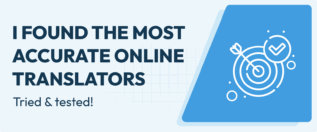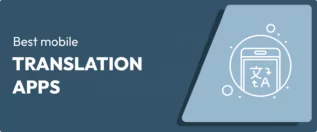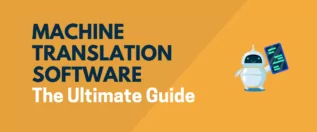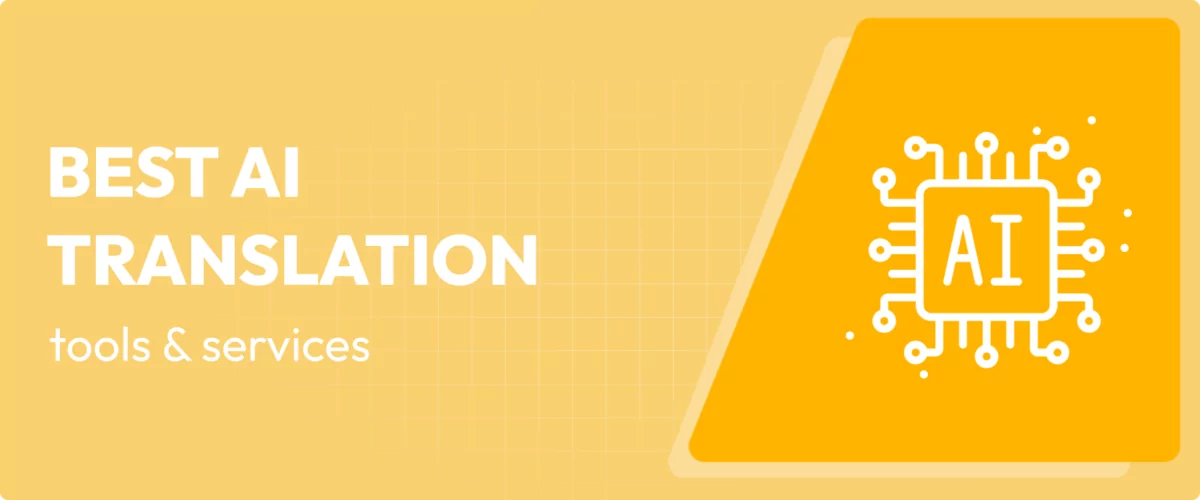
In this post
Like many other areas of life, translation is one where artificial intelligence (AI) increasingly plays a role. Most machine translation tools online are working on integrating their offers with AI or have already done so. And these AI translation tools and services promise to revolutionize the way translation works, making it faster and cheaper while preserving language integrity. If you are considering working with such a tool, you might be pondering a range of questions:
- Is it accurate enough, especially in contexts where nuance and specific terminology are important (e.g., legal, medical, or technical fields)?
- What are the benefits of using AI translation in comparison to human translation or even “classic” machine translation?
- Where do translator tools driven by artificial intelligence fall short? What do you need to pay attention to when using them to avoid mistakes?
- Which are the best tools and services for your particular use case?
- And finally, how can you use AI translation for your WordPress website?
We aim to answer that and more in the following post, so if you want to get on top of the AI translation game, stick around.
Understanding AI Translation: The Basics
Let’s start off with defining exactly what AI translation is, how it works, and the pros and cons of using it.
In the end, AI translation is simply machine translation, meaning translating text with computers instead of humans. However, it uses artificial intelligence technologies, particularly machine learning, natural language processing, and neural networks for better accuracy.
Not sure what any of this means? Then let’s dive into it a bit more.
How Do AI Translation Tools Work?
Unlike traditional translation methods, which often rely on direct word-for-word replacement, AI translation systems learn from vast amounts of data to understand and interpret language patterns and context.

The systems analyze bilingual or multilingual text data, learning the nuances, syntax, and semantics of different languages. They then use algorithms to detect patterns and make predictions about how words and phrases correspond to each other in order to provide accurate translations.
Advanced models also incorporate contextual information. That means they consider entire sentences or paragraphs to provide translations that are not just literal but contextually appropriate.
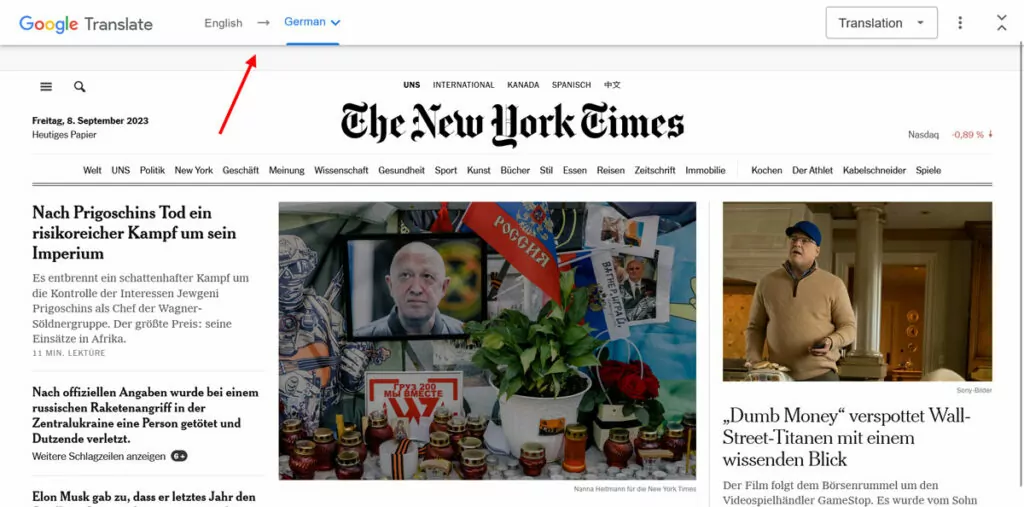
Thanks to the popularity of ChatGPT, there is also a new aspect that comes into it. Because of the ability of generative AI (which is what ChatGPT is), AI translation increasingly includes the ability to improve the content in the target language. It’s also better at recognizing context and generating translations that accurately reflect the original content’s context, tone, and meaning.
“Classic” translation AI is not always generative AI but there is a lot of overlap in these two technologies.
The Benefits of Using Artificial Intelligence for Translating
How does working with AI systems improve the translation process? Here are a few of the benefits this method of translating offers:
- High accuracy — Compared to older forms of machine translation, AI translation software is more accurate and better at accounting for context and nuances in their translation.
- Speed — Like machine translation in general, AI systems can translate large volumes of text much faster than human translators. It basically happens in real-time.
- Scalability — They can handle translating multiple languages and dialects simultaneously, which is a challenge for human translators. Usually, you would need an agency or work with many smaller companies for that. AI translation capabilities also go beyond text, as we will see below.
- Cost-effectiveness — Using AI translators reduces the cost associated with professional translation services, especially for large volumes of text.
- Learning ability — AI systems improve over time, learning from new data and user corrections. They are constantly improving their accuracy and fluency.
- Customizability — Some AI translation systems offer options to train their models on specific jargon or language styles, making them more suitable for specialized fields and industries.
- Ease of use — Most systems simply need you to input text and will spit out the translation automatically. For website translation, you can also use a plugin like TranslatePress, which comes with its own AI solution, TranslatePress AI, and allows you to connect to other translation AI providers.
Existing Challenges and Limitations
At the same time, there are also areas in which AI translation struggles:
- Context and subtleties — While they are better at it, AI systems may still not be able to translate idioms, slang, and culturally specific references accurately. AI also cannot fully grasp emotions and may miss the tone or cultural sensitivity required in certain translations. These are very basic translation problems that often need human intervention to work out.
- Legal and ethical concerns — In areas where precision is paramount, like legal or medical fields, reliance on AI translation can raise ethical and legal concerns due to the potential for errors.
- Problems with rare languages — AI translations for less commonly spoken languages may be less reliable due to limited available training data. They are among the hardest languages to translate for any kind of machine translation.
- Data dependency — Generally, the quality of AI translation is heavily dependent on its training data points. If there isn’t enough or if it is of bad quality, the translation quality will suffer. This is a problem with all AI models and can lead to things like language bias.
- Privacy concerns — Use of AI translation in sensitive or confidential circumstances raises concerns about data privacy and security. You might not know what will happen to your information after you upload it.
In short, AI translator tools struggle with a lot of the same things that make translation difficult for humans. What they have going for themselves is the fact that they are faster, cheaper, and more scalable in comparison to human translators. Additionally, they are more precise than older methods of machine translation.
But, in the end, like general machine translation, it’s usually best to combine them with expert human translators in order to avoid critical errors.
My Top 10 AI Translation Tools and Services
Now that we know more about the pros and cons of AI machine translation, let’s look at some of the best tools out there that offer translation supported by artificial intelligence. We will also talk about the best use cases for each of them.
1. TranslatePress AI
TranslatePress AI is a powerful new AI tool specifically for website translation. It lets you automatically convert your WordPress website into another language using a combination of the world’s leading neural machine translation tools, such as DeepL and Google Translate.
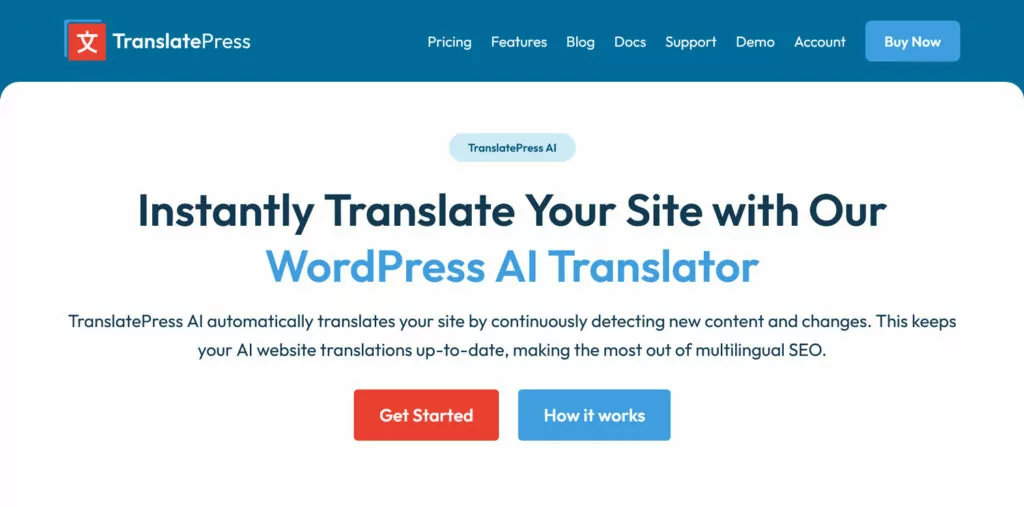
What’s cool about it is that you don’t need to concern yourself with setting up APIs or similar technicalities. The process is pretty much plug-and-play, as you will see in the tutorial further below on the page. You basically just have to enter your license key, choose your target language(s), switch automatic translation on, and TranslatePress AI will handle the rest.
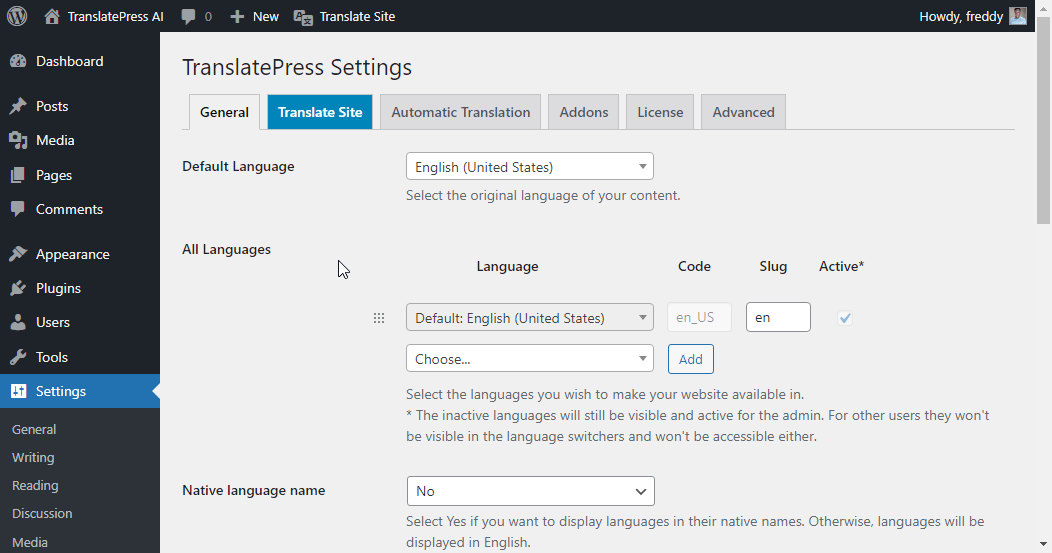
That includes choosing the most suitable translation engine for any language pair to ensure maximum accuracy. In addition, TranslatePress AI translates new content on your website automatically as publish it. This includes SEO metadata to ensure your website follows multilingual SEO best practices. Finally, you have the possibility to review and manually correct translations as needed.
Every premium plan of TranslatePress comes with a set number of words you can automatically translate with TranslatePress AI:
| Plan | Number of included words |
| Personal Plan | 50,000 |
| Business Plan | 200,000 |
| Developer Plan | 500,000 |
If you exceed these limits, extra allotments of words are available for purchase in your TranslatePress account. 100,000 additional words cost €24.00 (about $26.00), you can purchase 200,000 words for €40.00 (about $46.00), and 500,000 for €90.00 (about $98.00).
But even if you don’t have a TranslatePress license, you still have the possibility to take advantage of AI translations by connecting your site to Google Translate. We’ll show you how to do so below as well.
2. DeepL
DeepL Translator has gained acclaim for delivering some of the most accurate translations, especially in European languages. It supports over 30 languages, including English, German, French, Spanish, Chinese, Polish, Turkish, and Indonesian. Its focus seems to be less on providing every language available and more on being really good in those that it offers.
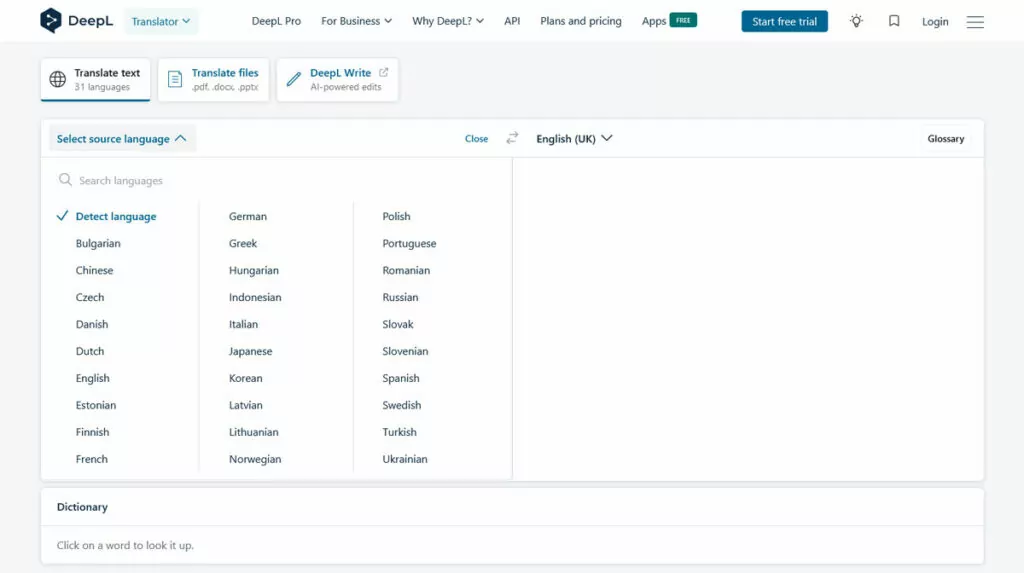
The latter is made possible thanks to the use of neural networks. They help produce accurate and contextually appropriate translations, including in legal, academic, and technical topics.
DeepL offers instant online translation including for documents like PDFs, Word Docs, PPTs, and more. It also preserves the original formatting of translated files. Additionally, the translation service offers the possibility to add a glossary and even comes with an AI assistant to improve writing. Finally, it has apps for Windows, iOS, and Android, comes with browser integrations, and has a strong commitment to confidentiality.
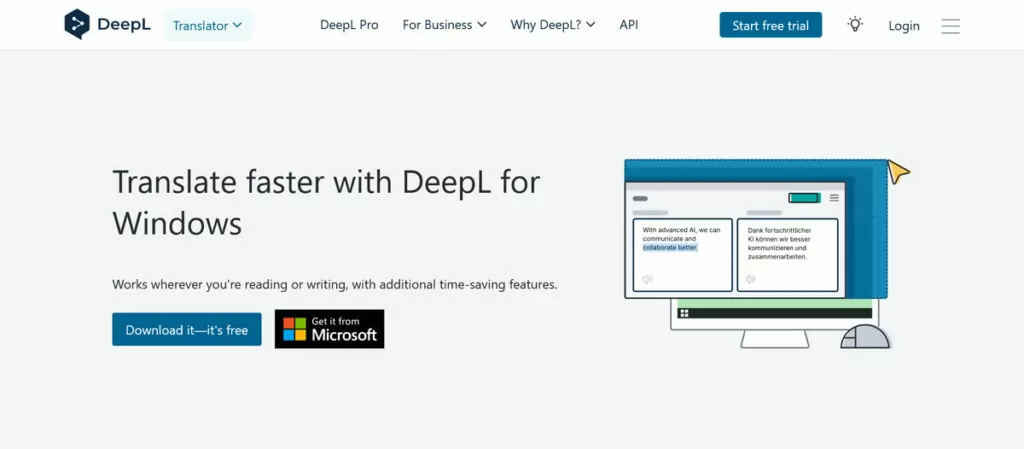
All of the above makes DeepL particularly well-suited for professional environments. It offers a free version with limited functionality, and paid plans start at $8.74, with a 30-day free trial available.
3. Google Translate
Google Translate is a pioneer in AI translation. It was one of the first machine translation tools on the market and is therefore hugely popular. The service is renowned for its extensive language support, covering over 100 languages, though it does better at some languages than others.
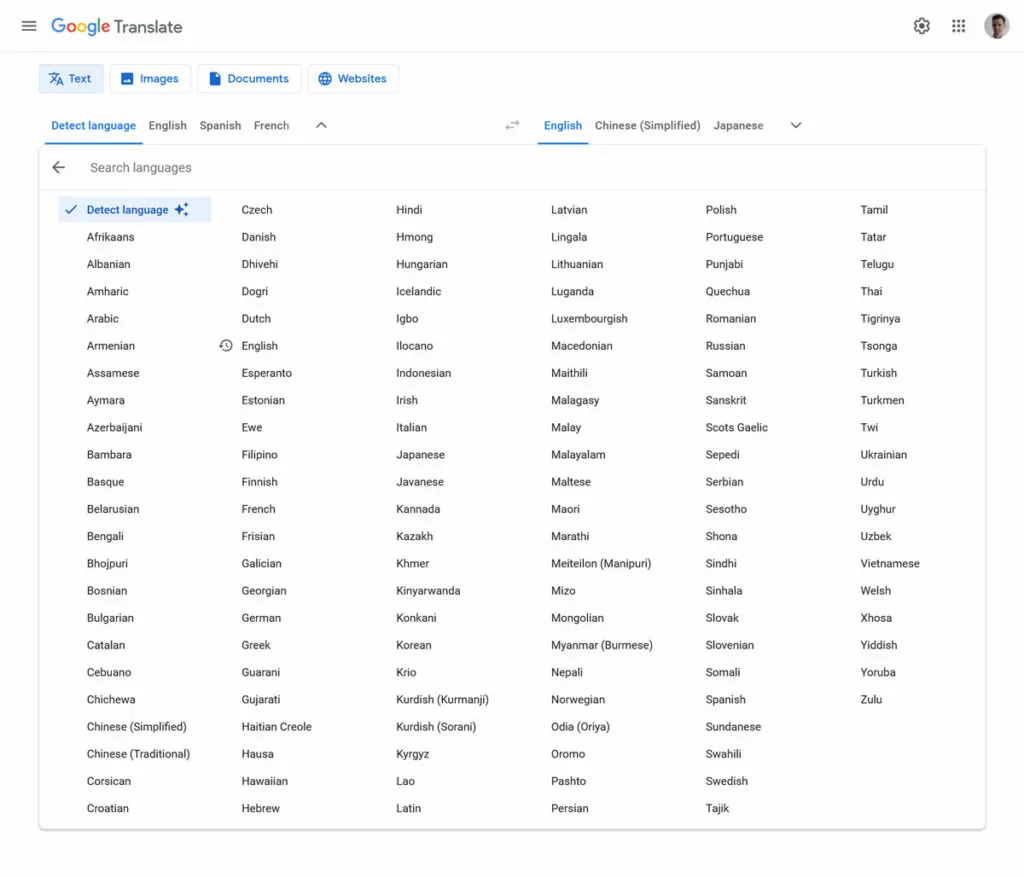
Google Translate updated to neural translation in 2020 and has been improving ever since. It offers real-time text and speech translation capabilities and you can put together your own phrasebook. The AI translator can also translate documents and websites directly in the browser (as seen at the beginning of this post).
Another standout feature is its ability to translate images and blend translated text automatically into the new visuals.
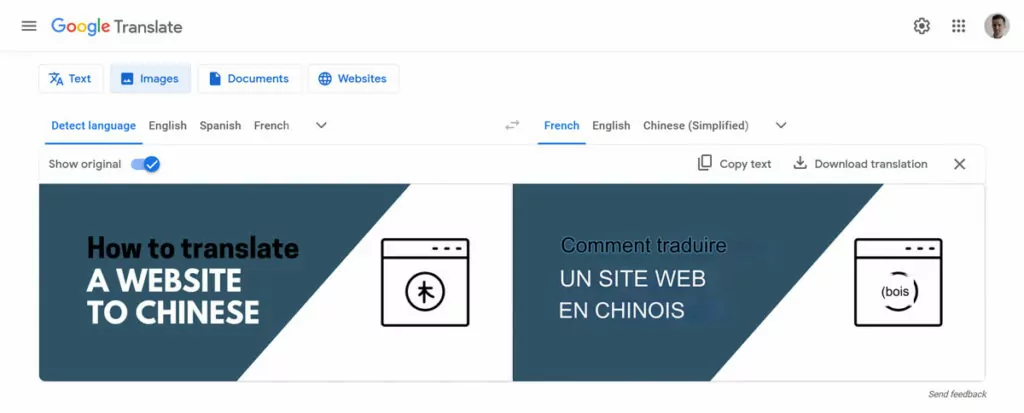
Google Translate also has a mobile app that can translate text by pointing your camera at it and also offers an offline mode, which is particularly handy in areas with limited Internet access.
It works best for general-purpose translations, travel assistance, and providing a quick solution for personal and informal use. It is completely free, though there is a paid API.
4. Microsoft Bing
Microsoft is at the forefront of AI development and was the first to add an AI assistant to their Bing search engine. They also offer AI-supported translation tools.
At its most basic, it can do online text translation, similar to Google Translate or DeepL, for more than 130 languages.
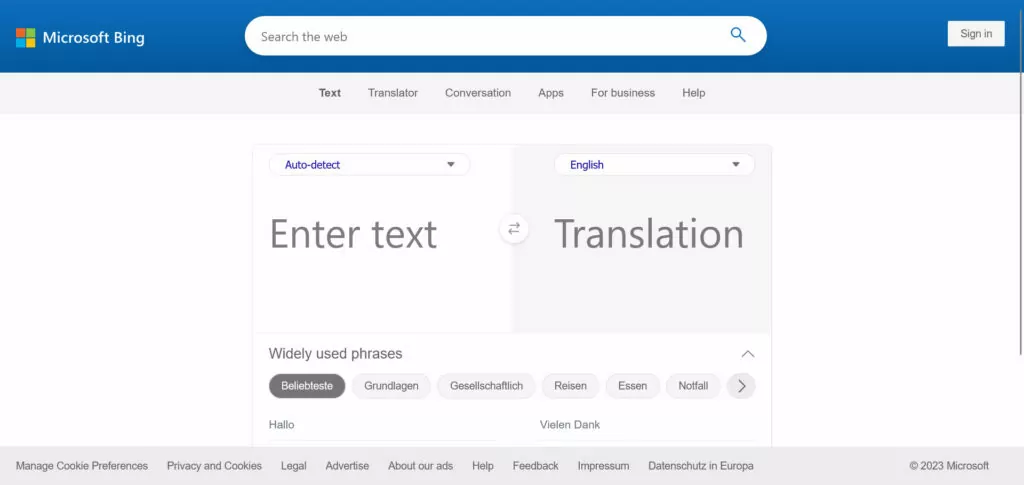
In addition, via a mobile app, you can take advantage of speech translation and even translate live conversations in and from 45+ languages.
Where Bing Translator really shines is that it integrates seamlessly with other Microsoft products, including Office, Skype, Edge, and Visual Studio. That makes it especially suited for document translation.
You can also use it for specialized topics and customize the model to your industry, which is why it’s often valued in professional and educational settings.
5. ChatGPT
ChatGPT is probably what most people think of when they hear AI. It woke up the world to what artificial intelligence is capable of with its human-like text responses and writing capabilities. However, it is also able to translate text as well as use its language capabilities to improve the in- and output.
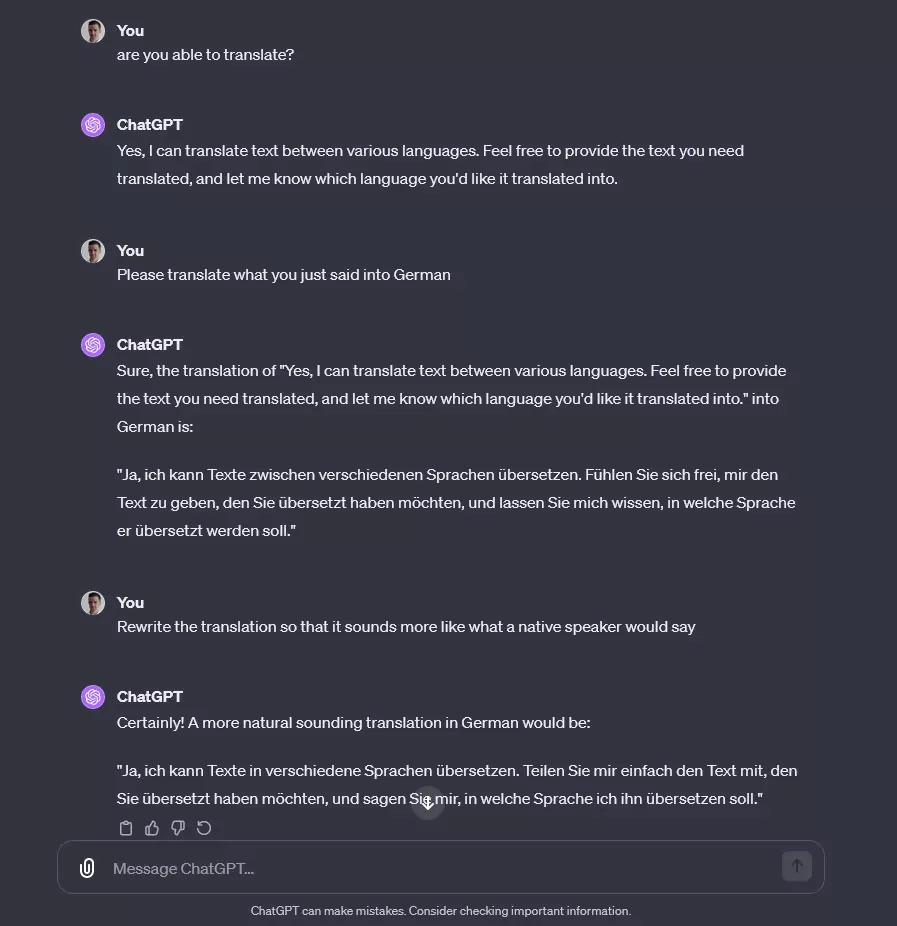
You can simply prompt ChatGPT to convert text into another language, and then use it to polish the results. It can also translate documents you upload and covers more than 50 languages.
In addition, you can find ChatGPT integrated into many other services that use AI translation, including Lokalise. It also forms the basis for the aforementioned Bing Chat.
But, be aware that translation is just one of the things that ChatGPT does and not its main purpose. It is missing important functionality, such as glossaries or style guides. Depending on which version you are using, it is also not necessarily the fastest and has a limit on how much text it will process.
Additionally, just like for other machine translation, it makes sense to run the results by an expert before using them. ChatGPT has a free version, with a premium plan priced at $20/month.
6. Copy.ai
Copy.ai is similar to ChatGPT. It’s an artificial intelligence for content creation and optimization that also has translation capabilities.
What’s helpful is that you can add your own brand voice guide, which helps with transcreation and localization of your voice and marketing message. You can use this AI translator for sales and marketing material, customer support, documentation, press releases, blog posts, email sequences, and more.
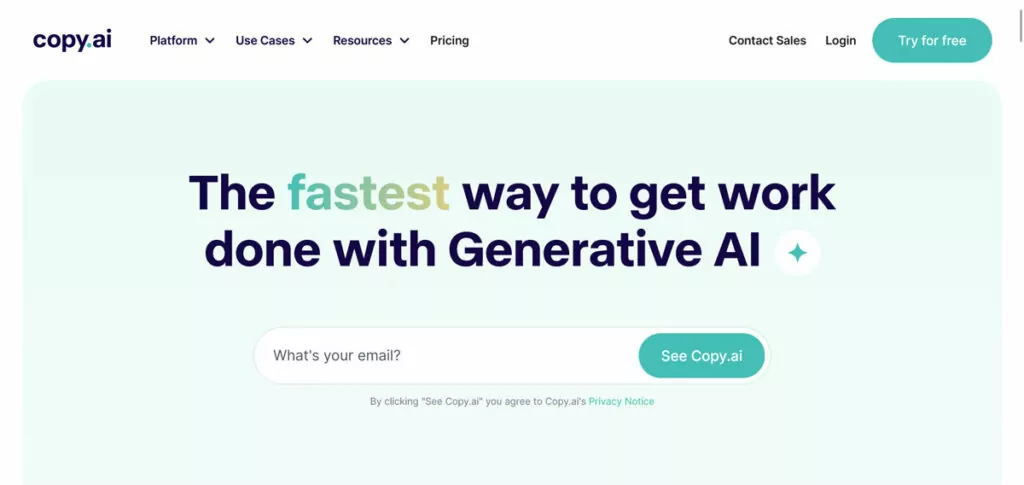
However, again, Copy.ai is not primarily a translation software. Therefore, while it is better at outputting polished language, you should definitely check the translation quality in other ways, meaning with a knowledgeable real-life translator.
Copy.ai offers support for more than 25 languages and has a strong emphasis on data privacy. It comes with a limited free plan, paid plans start from $36/month.
7. Google Bard
Bard is Google’s AI assistant, which they are also experimenting with in their new search experience. Like other AI chatbots on this list, it can do translations and supports 26 languages (according to itself).
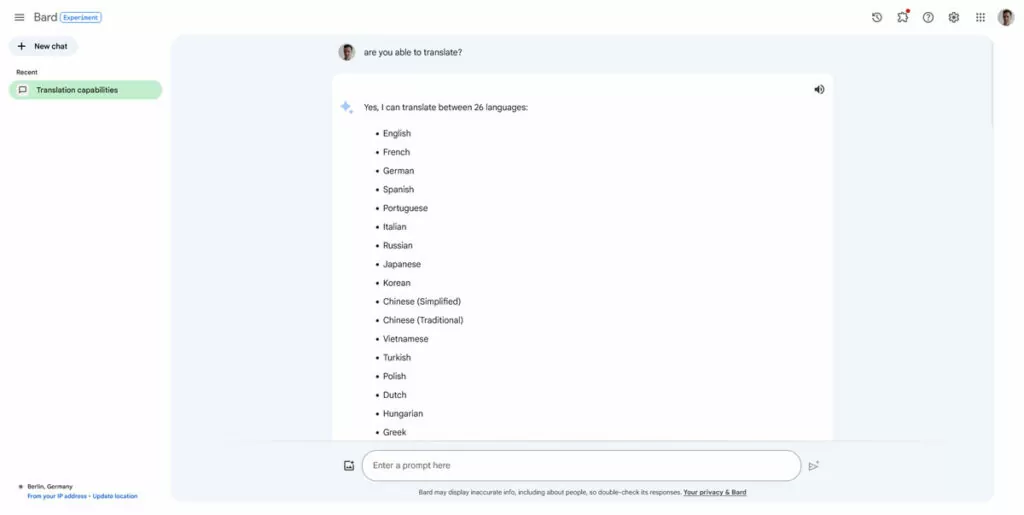
You can use Bard for text translations and also upload images and ask it to translate anything written in them. However, there are no other options such as file uploading or adding a glossary or style guide. But you can tell the chatbot to assume a certain persona or change the tone of both your source text and the translated result.
Again, however, Bard’s functionality is not primarily translating, so proceed with caution. It is free of cost, for the moment.
8. Systran
Systran is one of the oldest translation services around. It is one of the pioneers in machine translation, so it’s no wonder that they have updated their services with AI capabilities.
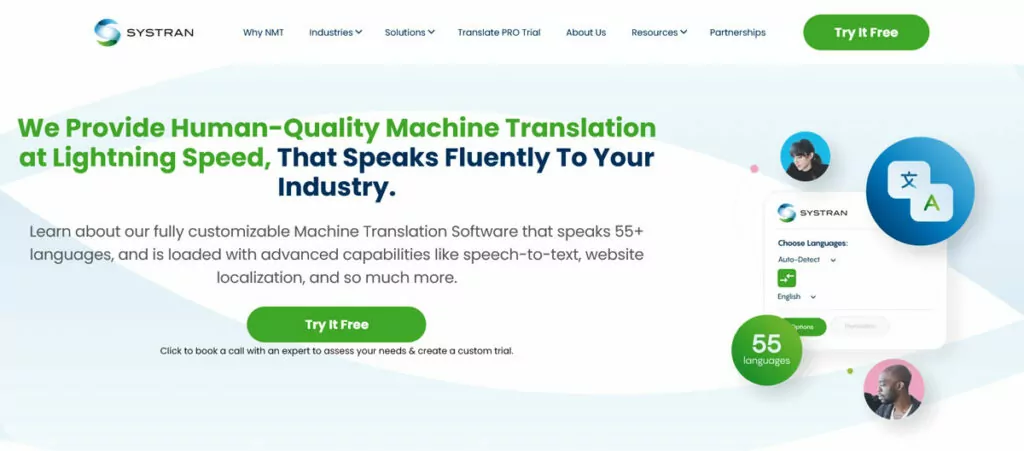
Systran supports more than 55 languages and 150 language pairs and has industry-specific training data for many industries such as banking and finance, healthcare, legal, and government. You can also train your own AI model.
Systran is known for its robust privacy policy, making it suitable for sensitive translations. Besides their AI translation software, they also offer real-time online translation for text and documents. The latter are free, but if you want access to their AI translation models, you need to book a call. Have a look at our Systran review for more information.
9. Wordly.ai
Wordly.ai is an AI translation tool that stands out a bit as it has a different focus than most other entries on this list. It specializes in providing live translations and captions for meetings and events.
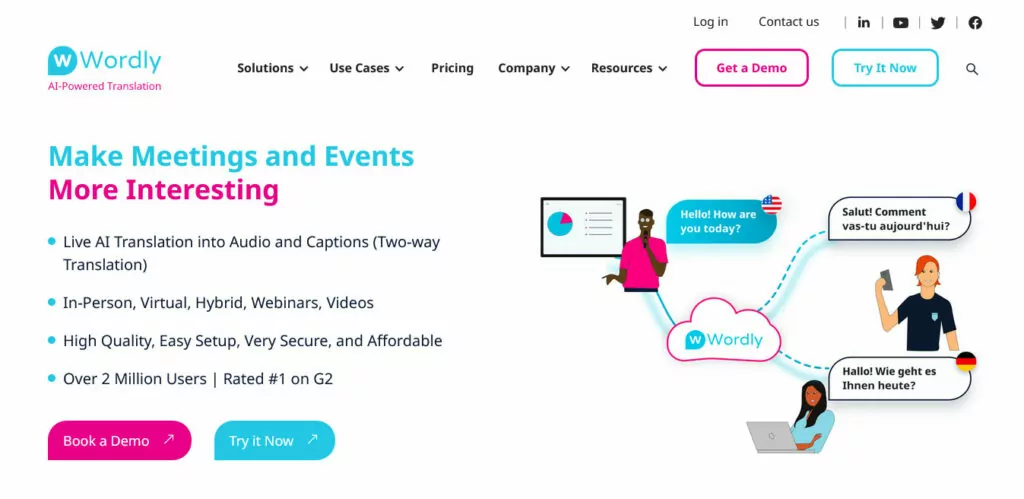
The service supports more than 50 languages and over 2,000 language pairs. It works for in-person, virtual, hybrid, webinars, videos, and integrates with major conference platforms like Zoom and Microsoft Teams. You can use glossaries and blocklists as well as receive translated transcripts of your meetings.
Wordly.ai charges by the hour and according to the number of attendees. For more detailed pricing information, you can schedule a call or sign up for an account.
10. Sonix
Sonix is another AI translation service that’s a little bit different. It focuses on AI-powered transcription and video translation, with the ability to automatically create subtitles.

The AI translation software has collaboration features, custom dictionaries, and integrates with popular applications, from Zoom to Adobe Premiere.
Sonix charges per hour of transcription, either as you go or with a subscription. There is a free trial available to dip your feet in.
Other Notable Mentions
Besides the top players above, there is a smattering of other online tools that offer AI translation services for different purposes:
- Amazon Translate — A translation tool that’s available via API. It supports more than 5,500 translation combinations across 75 languages and is aimed at customer communication and support.
- Yandex Translate — A popular machine translation choice especially in Eastern Europe and Asia. Yandex Translate can convert text, images, websites from a link, and documents. It also has translation features in its browser, especially for Russian.
- Promt — Promt specializes in translating large documents and offers several neural machine translation products with advanced customization. It is ideal for businesses and professionals and supports 40+ languages.
- iTranslate — This tool has over 100 languages and has its own AI model named Grammatica. It features voice-to-voice conversations, text translation in camera, offline mode, and an extensive dictionary. This makes it ideal for travelers and language learners who need quick, accessible translation on mobile devices.
- Papago — An AI-supported translation and language-learning app that focuses on Asian languages. It shines in conversation translation, image translation, real-time voice translation, and comes with a dictionary and phrasebook.
How to Translate Your WordPress Website With AI Using TranslatePress
If you are running a website based on WordPress and want to bring the power of AI translation to it, there’s nothing easier than that. As mentioned above, TranslatePress offers several ways for that. Let’s go over them one by one.
TranslatePress Multilingual
1. Use TranslatePress AI
The easiest method to translate your site is to use the aforementioned TranslatePress AI. The process really is as easy as described above. First, choose your target language(s) and save at the bottom.
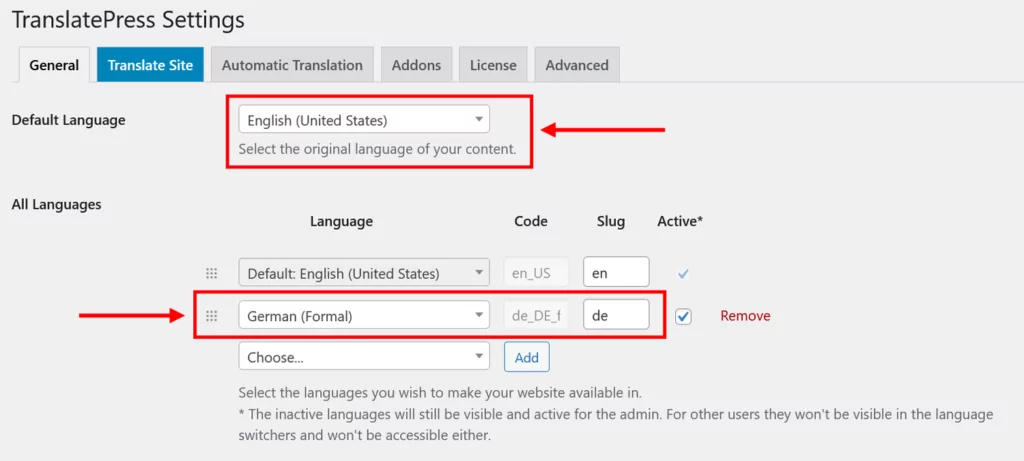
Then go to the Automatic Translation tab, set Enable Automatic Translation to Yes and save again. That’s it.
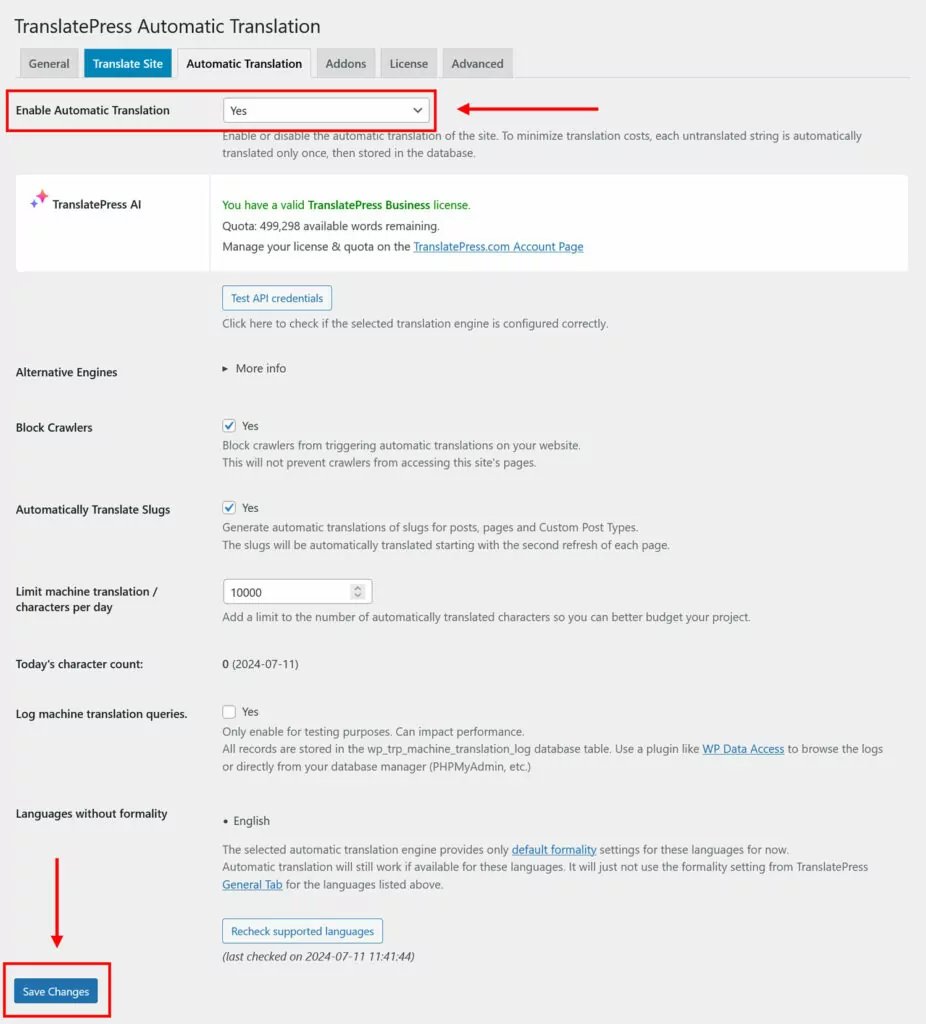
When you now go to the front end of your site and use the language switcher to see another language version, you should see the translation already completed.

2. Use Another AI Translation Engine
Yet, you are not locked into TranslatePress AI as your translation engine. Even if you are using the free version of TranslatePress, you can still have your website automatically translated by an AI translation tool, namely Google Translate.
For that, follow the general steps above, however, after you enable automatic translation, go to Alternative Engines, click More Info, and then pick Google Translate as your choice.

If you own a Business or Developer license can also opt for DeepL.
The next step is to obtain an API key for your AI translation software of choice. Follow our guides for how to do so for Google Translate and DeepL. You can also use the link underneath the input field to find these instructions.

After providing the API key and saving, you are pretty much good to go and should find your website automatically translated. You might also want to look at the available settings to possibly limit the number of characters to translate automatically per day.
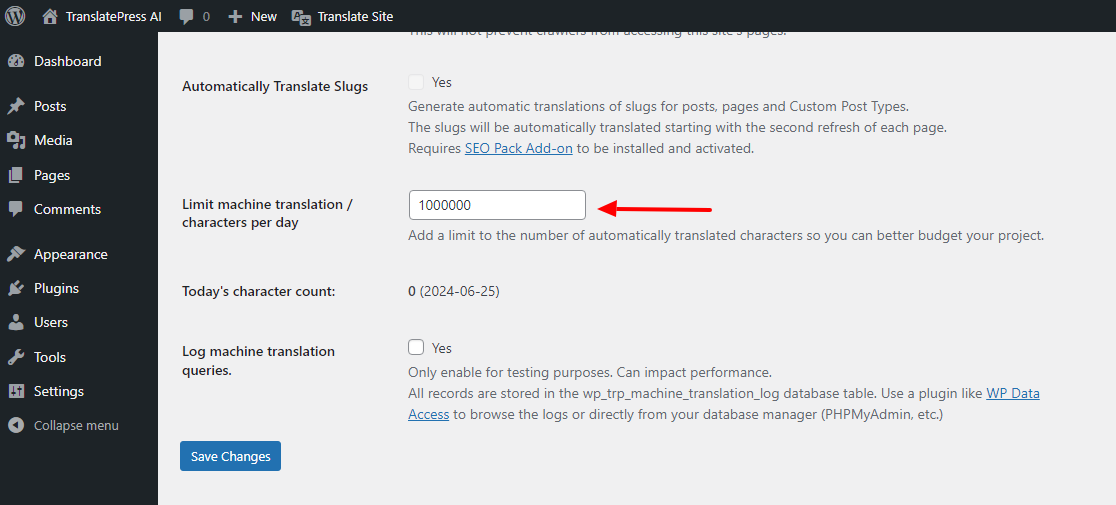
This can be important to limit costs, which can occur from using Google Translate and DeepL. Be aware that this doesn’t run through TranslatePress but it’s something you arrange with the providers directly. The menu also shows the number of daily characters you have already translated automatically.
3. (Optionally) Make Manual Corrections
Both methods above let you end up with a website automatically translated by artificial intelligence. Just in case you feel like your translation tool of choice did not fully grasp the meaning of some of your content, you can manually correct it.
For that, first click on Translate Site in the admin bar or TranslatePress settings.

This gets you to the main translation interface of TranslatePress. It has a preview of your site on the right and translation tools on the left.

Use the preview on the right to navigate to the page you want to convert to your target language. After that, choose your desired content through the drop-down menu, forward and backward arrows, or by clicking on any string in the preview screen.
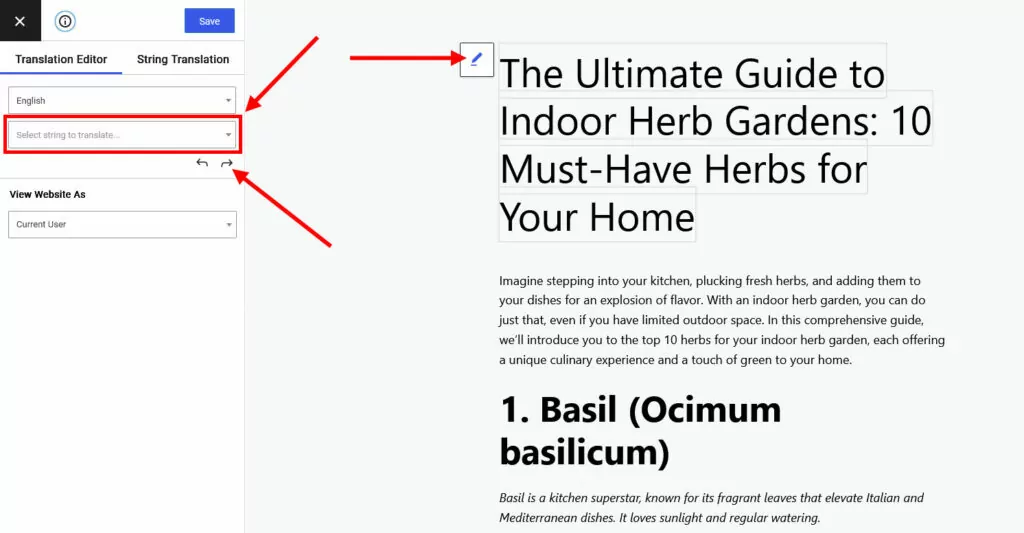
The moment you do, you should immediately see the input field for the target language filled in with a translation.
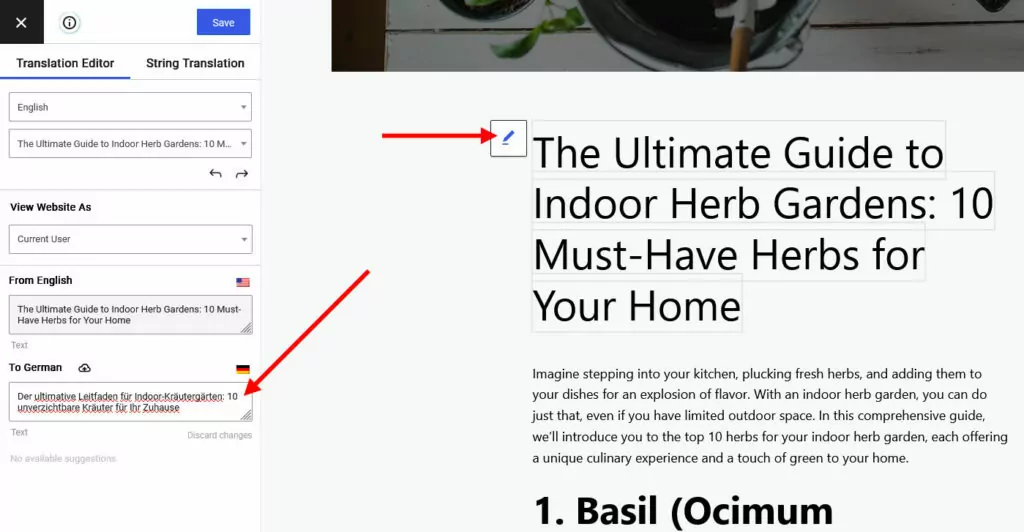
Check it for correctness and make any changes you want, then click Save (alternatively Ctrl/Cmd+S) to commit the translation to your site. Done.
Other Useful TranslatePress Features
Besides unleashing the power of AI translation on your website, TranslatePress additionally offers the following features:
- Image Translation — You can also provide alternative language versions of your visuals. It’s just as easy as doing it for written content and happens in the same interface.
- Multilingual SEO — Translate your page links, SEO titles, meta descriptions, ALT tags, and other important SEO elements with our multilingual SEO pack. It also creates sitemaps for your different languages you can submit to search engines and works with most of the popular WordPress SEO plugins.
- Translator Accounts — Create dedicated translator accounts to outsource the translation of your website to freelancers and agencies and have them work directly on your website.
- Language-specific navigation – The premium version allows you to provide different menus depending on the language chosen by the user.
- Automatic language detection – Automatically show your website in a user’s preferred language (via browser settings or location).
TranslatePress comes in both a free and paid version with three different pricing tiers. The free version lets you add one additional language to your WordPress site. Check the pricing table below for more information.
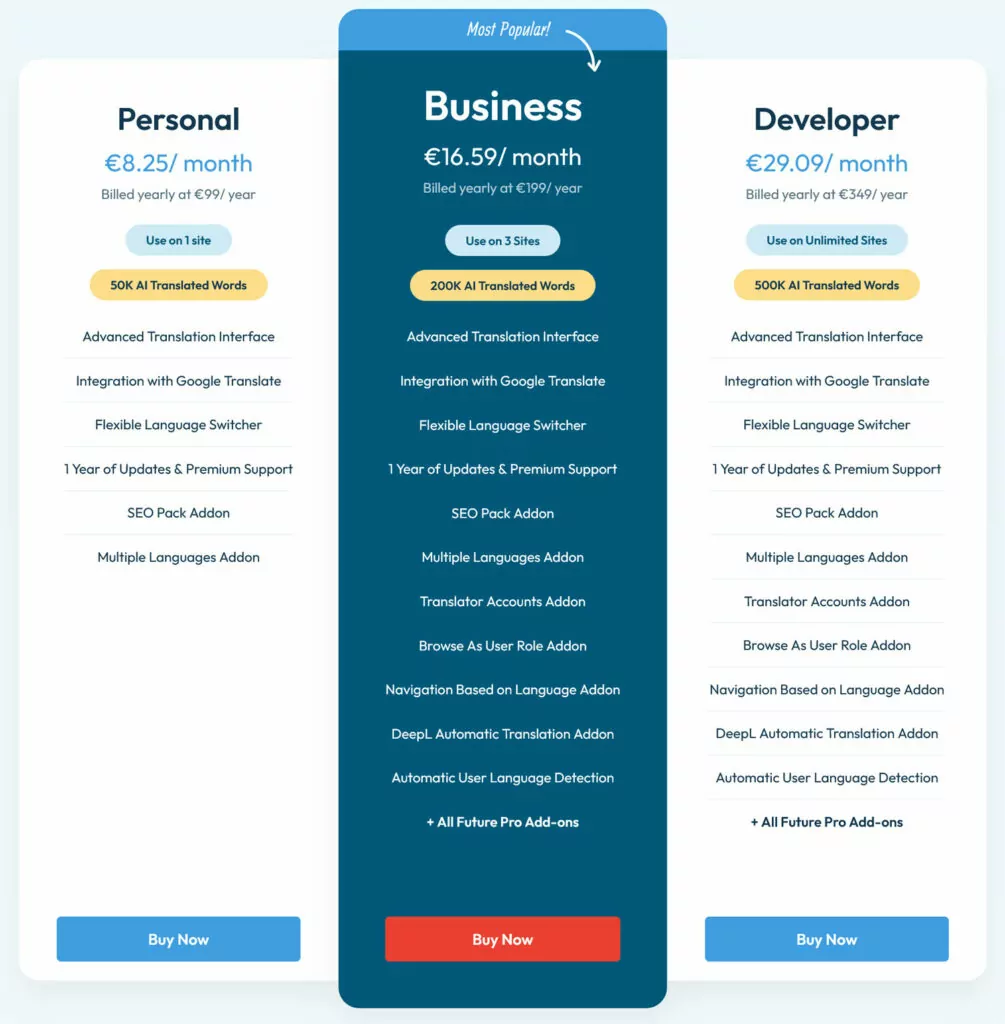
Take Advantage of AI and Start Translating Now!
AI-powered machine translation is quickly becoming the new standard. It promises better accuracy, nuance, and context awareness while maintaining the benefits of speed and cost-effectiveness of machine translation. While still facing the same concerns as general translation by machine, it’s likely to get better over time.
Above, we’ve looked at some of the best AI translation services and software that you can currently get your hands on to take advantage of this new technology. Even better, AI translation is also available in the back end of your WordPress website for a smoother website translation process.
Check out TranslatePress to use AI translation on your website.
TranslatePress Multilingual
What’s your favorite AI translation tool? Share it in the comments below!
